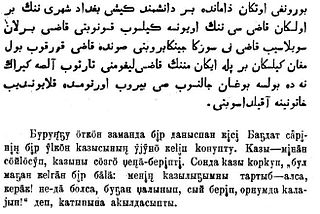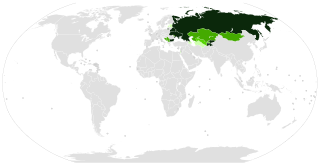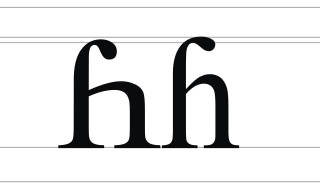Three scripts are currently used for the Tatar language: Arabic, Cyrillic and Latin.

Kha or Ha is a letter of the Cyrillic script. It looks the same as the Latin letter X, in both uppercase and lowercase, both roman and italic forms, and was derived from the Greek letter Chi, which also bears a resemblance to both the Latin X and Kha.

Tshe is a letter of the Cyrillic script, used only in the Serbian Cyrillic alphabet, where it represents the voiceless alveolo-palatal affricate, somewhat like the pronunciation of ⟨ch⟩ in "chew"; however, it must not be confused with the voiceless retroflex affricate Che (Ч ч), which represents and which also exists in Serbian Cyrillic script. The sound of Tshe is produced from the voiceless alveolar plosive by iotation. Tshe is the 23rd letter in the Serbian alphabet. It was first used by Dositej Obradović as a revival of the old Cyrillic letter Djerv (Ꙉ), and was later adopted in the 1818 Serbian dictionary of Vuk Stefanović Karadžić. The equivalent character to Tshe in Gaj's Latin alphabet is Ć.

Buryat or Buriat, known in foreign sources as the Bargu-Buryat dialect of Mongolian, and in pre-1956 Soviet sources as Buryat-Mongolian, is a variety of the Mongolic languages spoken by the Buryats and Bargas that is classified either as a language or major dialect group of Mongolian.

Three alphabets are used to write Kazakh: the Cyrillic, Latin and Arabic scripts. The Cyrillic script is used in Kazakhstan and Mongolia. An October 2017 Presidential Decree in Kazakhstan ordered that the transition from Cyrillic to a Latin script be completed by 2025. The Arabic script is used in Arabia, Iran, Afghanistan and parts of China.

Ha or He is a letter of the Cyrillic script. Its form is derived from the Latin letter H, but the capital forms are more similar to a rotated Cyrillic letter Che or a stroke-less Tshe because the Cyrillic letter En (Н н) already has the same form as the Latin letter H.

H with descender is a letter of the Latin alphabet, derived from H with the addition of a small descender. It was used in Uyghur to represent, while a regular H was used to represent.

Heng is a letter of the Latin alphabet, originating as a typographic ligature of h and ŋ. It is used for a voiceless y-like sound, such as in Dania transcription of the Danish language.

Abkhazian Che is a letter of the Cyrillic script.

En with hook is a letter of the Cyrillic script. Its form is derived from the Cyrillic letter En (Н н) by adding a hook to the right leg.

Numerous Cyrillic alphabets are based on the Cyrillic script. The early Cyrillic alphabet was developed in the 9th century AD and replaced the earlier Glagolitic script developed by the Byzantine theologians Cyril and Methodius. It is the basis of alphabets used in various languages, past and present, Slavic origin, and non-Slavic languages influenced by Russian. As of 2011, around 252 million people in Eurasia use it as the official alphabet for their national languages. About half of them are in Russia. Cyrillic is one of the most-used writing systems in the world. The creator is Saint Clement of Ohrid from the Preslav literary school in the First Bulgarian Empire.

Kha with stroke is a letter of the Cyrillic script. In Unicode, this letter is called "Ha with stroke". Its form is derived from the Cyrillic letter Kha.

Shha with descender is a letter of the Cyrillic script. Its form is derived from the Cyrillic letter Shha by the addition of a descender to the right leg.
The braille alphabet used for the Kazakh language is based on Russian Braille, with several additional letters found in the print Kazakh alphabet.

Hwe is a letter of the Cyrillic script. Its form was derived from the Cyrillic letter Shha by adding a hook to the top of the left leg.
Khakass alphabets are the alphabets used to write the Khakas language.
Je with belt, also called Bashkir Ye, is an additional letter of the Cyrillic script that was used in the Bashkir alphabet of Mstislav Aleksandrovich Kulayev in 1912.
Sha with breve is an additional letter of the Cyrillic script which was used for Abkhaz and Komi at the start of the 20th century. It is composed of a sha ⟨Ш⟩ with a breve.

Lev Grigorievich Lopatinsky was a Ukrainian and Russian linguist, philologist, ethnographer, historian and researcher of the languages of the peoples of the Caucasus.

Ka with ascender is a letter of the Cyrillic script which was used in Kabardian at the start of the 20th century.
This page is based on this
Wikipedia article Text is available under the
CC BY-SA 4.0 license; additional terms may apply.
Images, videos and audio are available under their respective licenses.
![]() ,
, ![]() ), also referred to as Heng, is a letter of the Cyrillic script formerly used in some alphabets in Kabardian and a 1908 alphabet for Chechen. [1]
), also referred to as Heng, is a letter of the Cyrillic script formerly used in some alphabets in Kabardian and a 1908 alphabet for Chechen. [1] 














